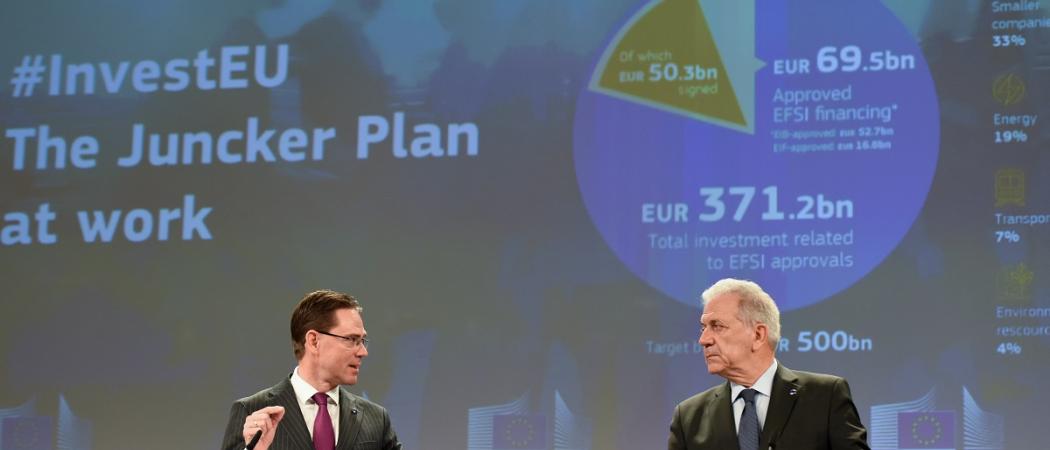‘Juncker Plan’ auditor says more information about rejected loan applications would have helped his analysis. Some east Europeans question funding decisions.

EU commissioners Jyrki Katainen and Dimitris Avramopoulos at a press conference on the impact of the Juncker Plan. Photo: Jennifer Jacquemart, European Commission
As the European Union contemplates a follow-on to its main economic stimulus programme, a senior auditor called for greater openness about the details of how the current programme operates.
In an interview following a recent European Parliament hearing, Leo Brincat, a member of the European Court of Auditors, said the audit of the so-called Juncker Plan would have been aided if officials had provided him more information about rejected loan applications.
“How many projects were refused? Why were these projects turned down? This was data never made available to us,” said Brincat in the Science|Business interview. “I know transparency is a trendy buzzword nowadays, but seriously, you cannot have a big picture of such an initiative […] if you only look at what has been approved, and you don’t have any idea of what has been refused.”
The court’s audit, published in January, said the Commission and the European Investment Bank had overstated the benefits of the Juncker Plan and that most of the money was invested in a few west European countries. Since the release, Brincat has been explaining the findings publicly – and some east European politicians have raised questions about the programme’s fairness.
At a 21 March European Parliament hearing, Ivana Maletić, a Croatian conservative MEP, asked Brincat about the matter. “We all remember that at the very beginning the Commission and EIB were collecting project pipelines, ideas, and ready projects from the member states – so do you have information on what they refused?” she asked Brincat. She said she was particularly concerned by the finding that more than 50 per cent of Juncker Plan investments were concentrated in five large western states (France, Italy, Spain, Germany, and the UK) and said the EIB should have been trying “to decrease inequalities between the member states.”
The Juncker Plan was the flagship policy of Commission President Jean-Claude Juncker when he took office in 2014. It aimed to boost Europe’s economy by targeting investment where it was most needed. The plan’s main instrument is EFSI, which uses EU and EIB funds to guarantee loans that would otherwise be too risky to provide. EFSI’s planned successor is the InvestEU programme, which would use the EU budget to guarantee up to €38 billion of higher-risk loans, including €11.25 billion for research and innovation.
‘Nonsense’, says EIB chief
When the ECA report came out in January, EIB President Werner Hoyer dismissed concerns about geographic distribution of the guarantees as “nonsense” because the auditors did not factor in the relative GDP of different countries. The Commission protested that auditors had failed to show “the full picture.”
In the interview, Brincat said it was the Commission and the EIB, which work on the programme together, that didn’t present auditors with the complete picture of what happened. Due to limits to the court’s jurisdiction, auditors could not demand the documents officially.
“I’m not saying that there was any bias in the way things were judged. But definitely, we are not privy to the big picture,” said Brincat. “We’re not here to put them on trial,” he added; “we want EFSI to be a success.”
When asked for comment, a Commission spokesman said: “The ECA audit report on EFSI (the European Fund for Strategic Investment) does not list any weaknesses related to access to documents and the ECA was not refused access to any official documents relevant to this audit. Decisions on which projects are supported by EFSI are taken by an independent Investment Committee following EIB proposals. These decisions are made public and available online.” An EIB spokesman said the information Brincat referred to wasn’t part of EFSI, and was therefore beyond the scope of the audit.
How EFSI works
The dispute is over some administrative details of the programme. With EFSI, applicants – who may be seeking to fund new airports, broadband networks, computer installations or other projects – apply to the EIB for financing. EIB staff screen the applications for their suitability for EFSI loan guarantees then submit those they select to an independent Investment Committee for decision on whether to guarantee the loan. The question Brincat and Maletić raised involves those applications that never made it to the committee. Information on these proposed projects, said Brincat, is necessary to judge the Juncker Plan properly.
“Only by analysing the refused projects and the reasons why they are refused can one really understand whether there were fair criteria throughout the whole process,” said Brincat. "Unless we have such data, no matter how deep our analysis might be or our audit might be, we never have the big picture."
An EIB official said that the bank doesn’t regard loan applications as potential EFSI projects until the EIB’s management committee recommends them to the EFSI investment committee. Applications rejected before that point, from the EIB’s point of view, have nothing to do with EFSI.
In Brincat’s view, greater transparency would be in everyone’s interests, including those of the Commission and the EIB.
“I think they should be more down to earth in their communications, less triumphalist, and I think when you give a warts-and-all picture of what you are doing, you are more credible, and you’ll be enhancing your own image. It’s in our own interests to see the Commission and the EIB gain the public confidence that they deserve.”





 A unique international forum for public research organisations and companies to connect their external engagement with strategic interests around their R&D system.
A unique international forum for public research organisations and companies to connect their external engagement with strategic interests around their R&D system.